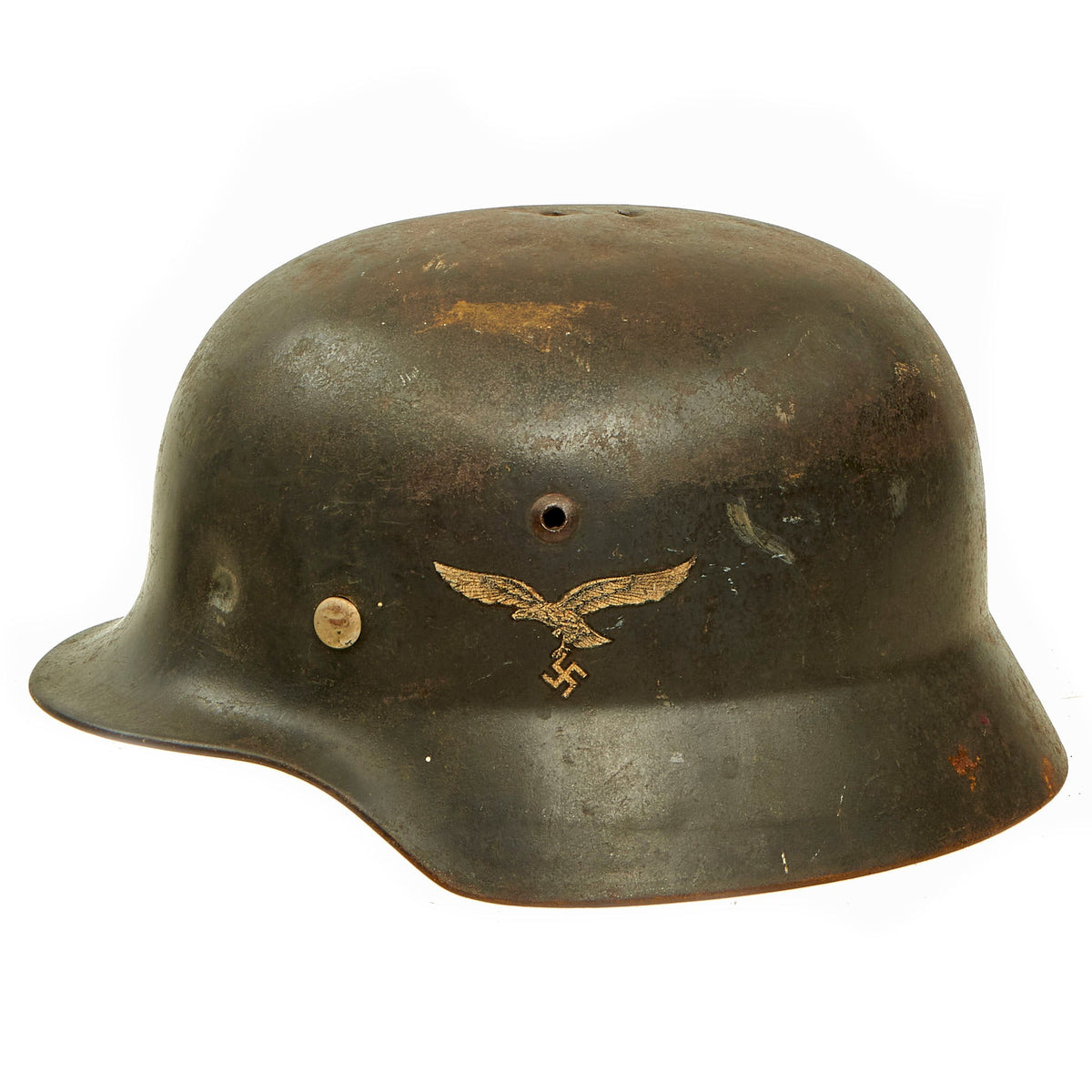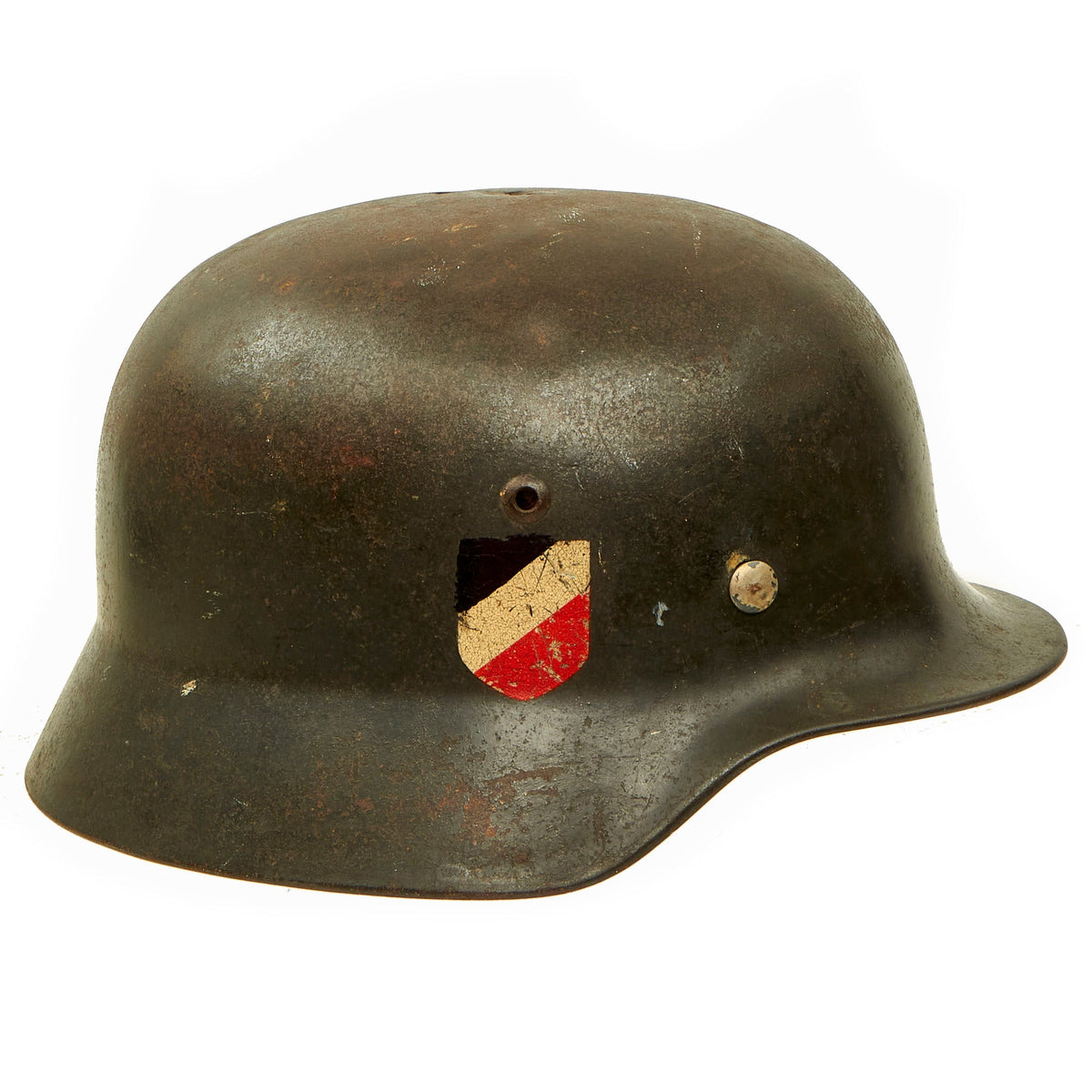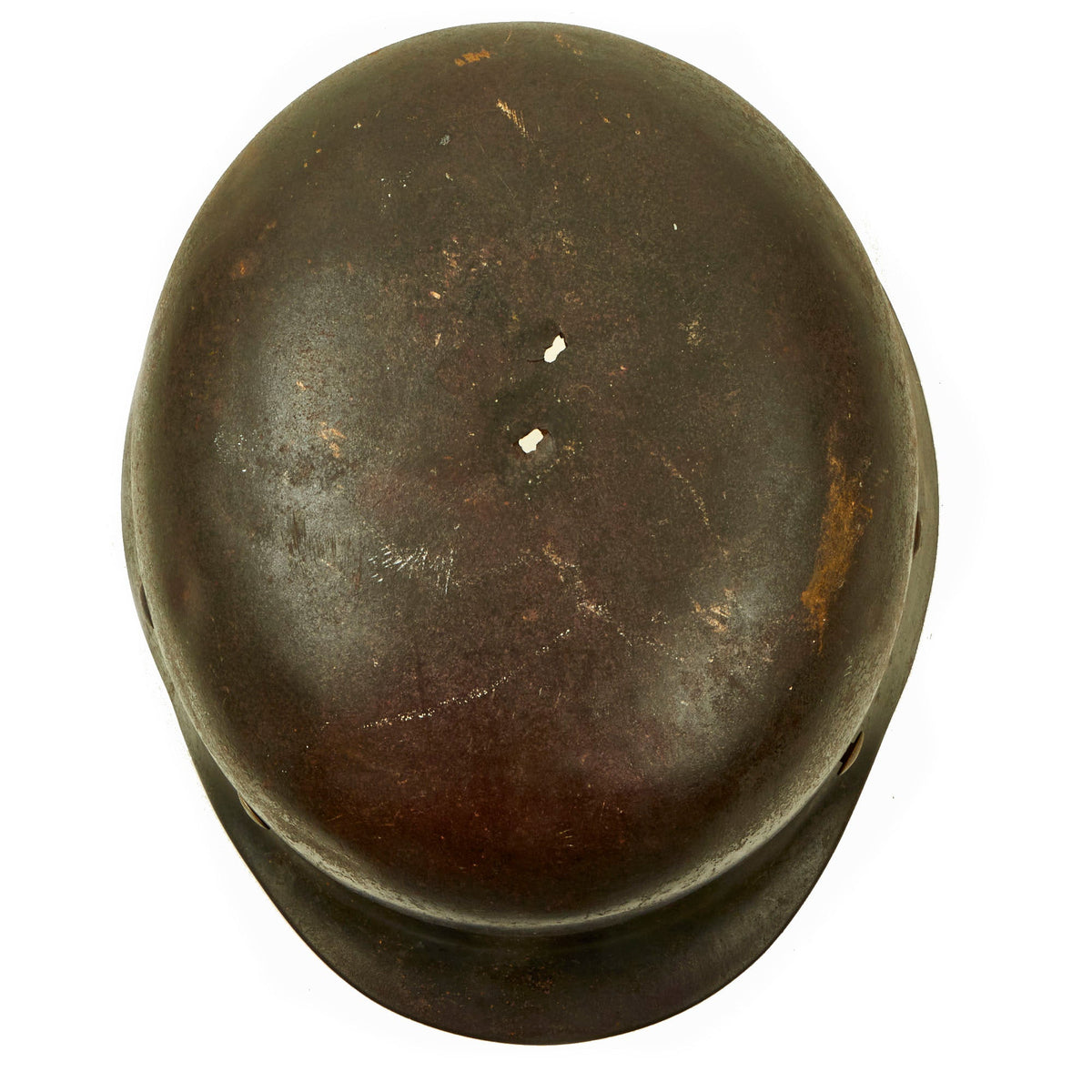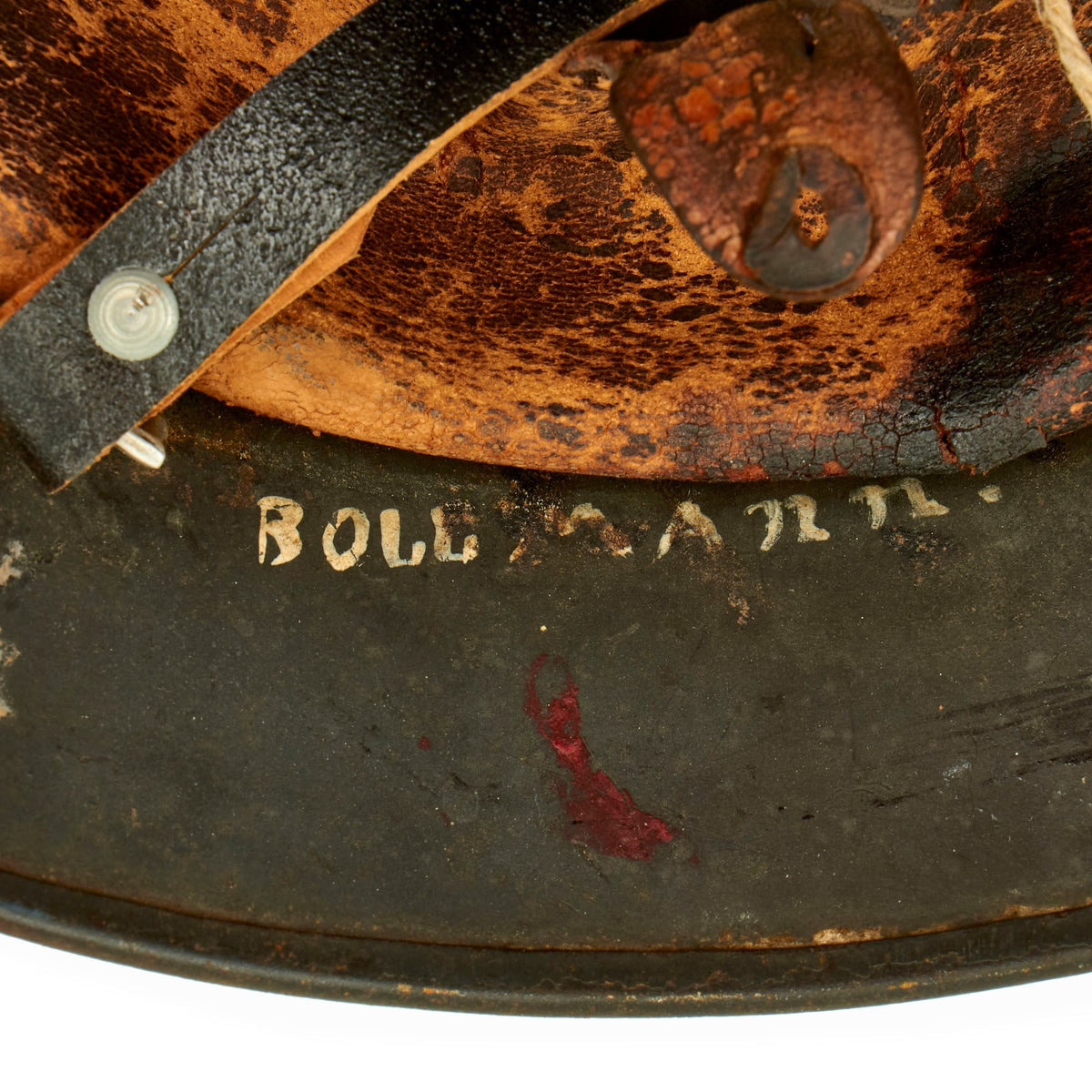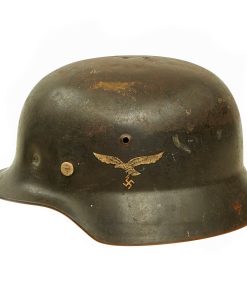Original German WWII Battle Damaged 1939 Dated Luftwaffe M35 Double Decal Steel Helmet with 61cm Liner – marked Q68 Original Items
$ 1.495,00 $ 373,75
Original Item: Only One Available. This is an great all original example of a Model 1935 German early WWII “double decal” helmet, complete with original liner, as well as some great “battle damage”! It features 2nd pattern Luftwaffe Eagle decal on the left side, and a “National Colors” decal on the right. The use of the second decal was discontinued in 1940, and in 1943 it was ordered that helmets with the national colors have them removed, so finding a helmet with both still intact is a real treat!
The Luftwaffe decal is probably around 90%, with a fantastic checked and cracked surface, caused when the lacquer top coat ages and starts to deteriorate. This only happens over decades, and has given the decal a fantastic look! The National Colors decal is also about 90% complete, with the same lovely pattern of cracks. The paint is the correct smooth blue-gray Luftwaffe fliegerblau (flyer’s blue) used on early helmets, which would later become textured, and is well retained at about 60%, with a lot of wear concentrated on the crown of the helmet, which now shows a lovely oxidized patina.
In the middle of the crown are two relatively small entrance holes, about an inch apart, with some cracking around them. These holes definitely look to be WWII period, and could definitely be the result of some type of trench raiding club. There is also a significant dent on the left front of the helmet right around the liner area, which has pushed in the liner a bit. This could definitely be from small arms fire, and if this helmet was worn at the time could very well have been a fatal injury, There is oxidation and staining on the interior shell of the helmet consistent with oxidation from moisture exposure, and the liner shows rust colored stains, possibly from organic matter.
The reverse, interior, neck guard apron is serial number stamped 20727 and the interior, left side, apron has the stamped manufacturer’s code and size Q68, indicating that it was manufactured by F.W. Quist G.m.b.H. in the German city of Esslingen. Size 68 is a rare extra large size that can accommodate liners from 60cm to 61cm or US 7 1/2 to 7 5/8. Size 68 shells are the hardest to find and are therefore more valuable to a collector. There also looks to be the name BOLLMANN in white paint near the liner.
All three liner retaining pins are intact, though they are the early non-magnetic nickel silver type, which has caused the paint to flake away for the most part. The helmet still has its correct condition M31 liner however it is definitely stained and deteriorated from moisture exposure. Only a few of the “fingers” are fully intact, and it is stained overall. The liner band is aluminum, with square aluminum chin strap loops attached to reinforced sides. This is the last pattern before the move to galvanized steel bands. The left exterior of the liner band is marked 68 n.A / 61, indicating that it is a size 61 liner for a size 68 shell. It is also maker marked and dated on the other side:
SCHUBERTH – WERK K.-G.
D.R.P.
1939
BRAUNSCHWEIG
There is the longer portion of a chinstrap installed, but it looks to be an unissued replacement or possibly a replica, and is definitely not original to the helmet.
Overall a very nice 100% genuine “battle damaged” double decal Luftwaffe helmet with nice decals a great look! We do not get helmets like these very often at all. Ready to display!
The first “modern” steel helmets were introduced by the French army in early 1915 and were shortly followed by the British army later that year. With plans on the drawing board, experimental helmets in the field, (“Gaede” helmet), and some captured French and British helmets the German army began tests for their own steel helmet at the Kummersdorf Proving Grounds in November, and in the field in December 1915. An acceptable pattern was developed and approved and production began at Eisen-und Hüttenwerke, AG Thale/Harz, (Iron and Foundry Works), in the spring of 1916.
These first modern M16 helmets evolved into the M18 helmets by the end of WWI. The M16 and M18 helmets remained in usage through-out the Weimar Reichswehr, (National Defence Force, Circa 1919-1933), era and on into the early years of the Third Reich until the development of the smaller, lighter M35 style helmet in June 1935.
The Luftwaffe pattern national eagle was originally introduced for wear by Fliegerschaft, (Pilot Base), personnel of the DLV, Deutscher Luftsportsverband, (German Air Sports Association), the clandestine, civilian, forerunner of the Luftwaffe on August 18TH 1934, and adopted for wear by the Luftwaffe on March 1ST 1935 along with the national tri-color shield for wear on the helmet.
The first pattern national eagle was utilized until a modified second pattern eagle was introduced in late 1936 or early 1937. Regulations of June 12TH 1940 discontinued the use of the national tri-color decal and further regulations of August 28TH 1943 abolished the national eagle decal and dictated that it was also to be removed from all helmets although the directives were not completely adhered to.
Fast Shipping with Professional Packaging
Thanks to our longstanding association with UPS FedEx DHL, and other major international carriers, we are able to provide a range of shipping options. Our warehouse staff is expertly trained and will wrap your products according to our exact and precise specifications. Prior to shipping, your goods will be thoroughly examined and securely secured. We ship to thousands clients each day across multiple countries. This shows how we're dedicated to be the largest retailer on the internet. Warehouses and distribution centres can be located throughout Europe as well as the USA.
Note: Orders with more than one item will be assigned a processing date depending on the item.
Before shipping before shipping, we'll conduct a thorough inspection of the items you have ordered. Today, the majority of orders will be delivered within 48 hours. The delivery time will be between 3-7 days.
Returns
The stock is dynamic and we cannot completely manage it because multiple stakeholders are involved, including our factory and warehouse. So the actual stock may alter at any time. It's possible that you may not receive your order once the order has been made.
Our policy is valid for a period of 30 days. If you don't receive the product within 30 days, we are not able to issue a refund or an exchange.
You can only return an item if it is unused and in the same state as the day you received it. You must have the item in its original packaging.
Related products
Uncategorized
Uncategorized
Uncategorized
Uncategorized
Uncategorized
Armored Burgonet Helmet & Polearm from Scottish Castle Leith Hall Circa 1700 Original Items
Uncategorized
Uncategorized
Uncategorized
Uncategorized
Uncategorized
Uncategorized
Uncategorized
Uncategorized
Armoured Fighting Vehicles of the World: AFVs of World War One (Hardcover Book) New Made Items
Uncategorized
Uncategorized
Uncategorized
Band of Brothers ORIGINAL GERMAN WWII Le. F.H. 18 10.5cm ARTILLERY PIECE Original Items
Uncategorized
Uncategorized
Uncategorized
